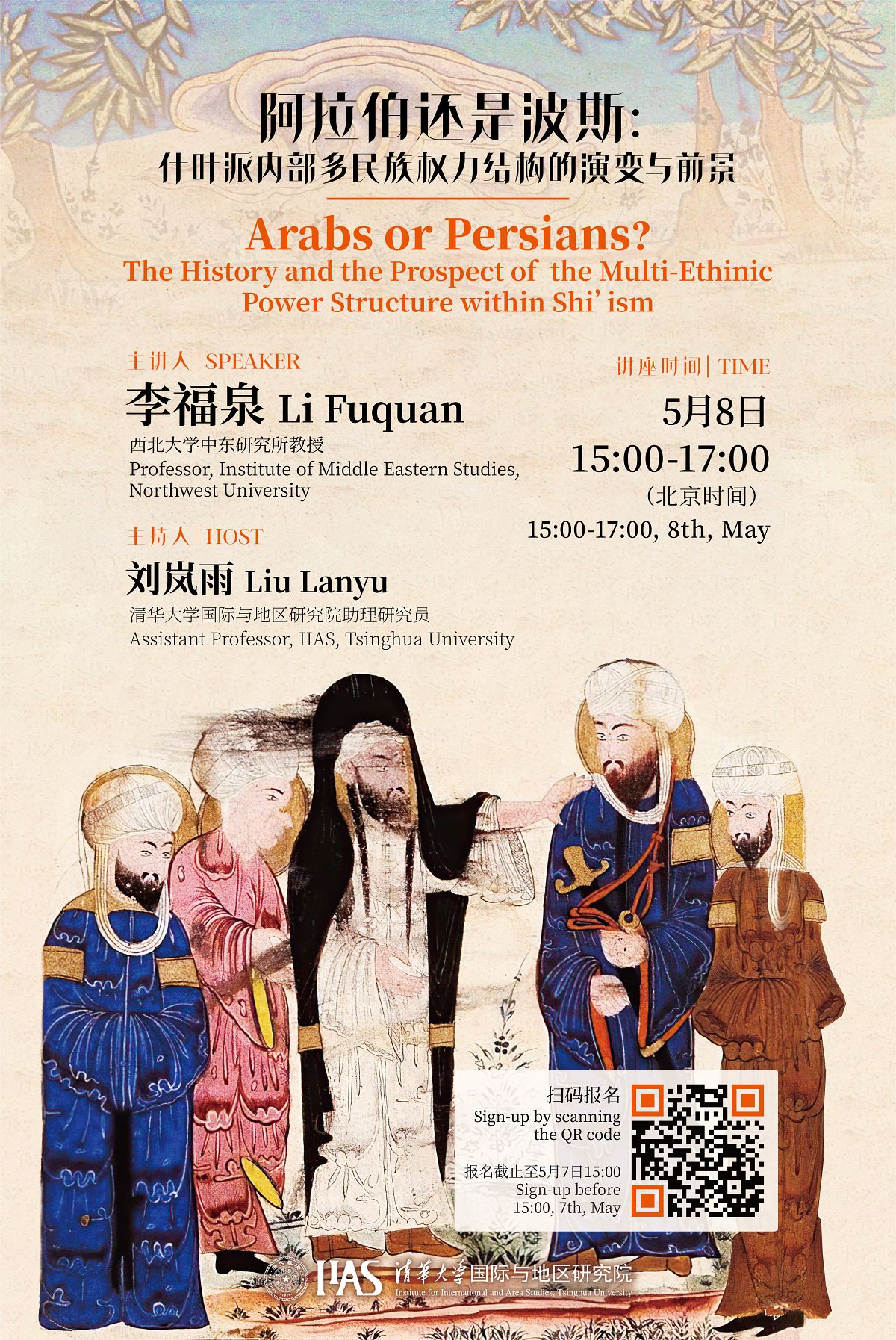
On May 8, 2022, Professor Li Fuquan from the Institute of Middle Eastern Studies at Northwest University gave an online lecture entitled “Arabs or Persians? The History and the Prospect of the Multi-Ethinic Power Structure within Shi’ism” for scholars from the Institute for International and Area Studies (IIAS) of Tsinghua University and audience from Tsinghua or other institutions. Liu Lanyu, Associate Professor at the IIAS hosted the lecture. Nearly 300 participants from the Cultural Council of the Embassy of the Islamic Republic of Iran in China, Al-Mustafa International University, and institutions and universities at home and abroad attended the lecture.
Professor Li took the historical timeline as the principle line and divided the evolution of ethnic groups within Shi’ism into six phases. Phase 1, from 632 to 1501, was the period of Arab-dominated Shi’ism, during which Shi’ism came into being and gradually spread across the Iranian plateau. Because of the dissident nature of Shi’ism, the sect characterized by opposition to the established authority was likely to resonate with oppressed groups. Phase 2 was from 1501 to 1722. During this period, the Safavid Dynasty, which ruled Persia, established Shi’ism as the state religion and Persians became the largest ethnic group of Shia thanks to the wide spreading of Shi’ism in Iran in the previous phase. It also marked the completion of Shia-ization in the Iranian plateau that led to the emergence of Persian cultural characteristics in Shi’ism, and the birth of religious schools represented by Isfahan with high Persian cultural attributes. Phase 3 was from the collapse of the Safavid Dynasty in 1722 to the establishment of the Qajar Dynasty in 1792, during which, wars continued in the Iranian plateau, and the Shiite center moved west from Iran to the Shiite Holy City in Iraq. Meantime, the Usuliyyah, which emphasized rationality, became the mainstream of Shi’ism and laid a solid foundation for Shia clerics (Shiite Ulama) to play a social and political role. Phase 4 was from the late 18th to early 19th centuries, during which the Shia mechanism of sources of imitation was generated, with the help of new printing and communication technologies, the Shia clerics gained the ability to exert influence on Iranian politics from abroad. Phase 5 was from the end of World War I to 1979, during which, the nation-states in the Middle East began to suppress and restrict the transnational Shia establishment and resulted in the Shiite center moving eastward from Iraq to the Iranian plateau again. At the same time, Shias in Iraq and Iran reformed themselves and began to challenge the secular nation-states. Phase 6 was from the Iranian (Islamic) Revolution in 1979 to the present. During this period, [Ruhollah Khomeini’s Theory of Guardianship](http://escholarship.ucop.edu/uc/item/4rg2c49c) facilitated its practices with the success of the revolution, and the religious circle and state power were integrated in Iran while the absolute advantage of Iran within Shi’ism was further expanded. After reviewing the evolution history of ethnic groups within Shi’ism, Professor Li concluded that the evolution and prospect of multi-ethnic power structure within Shi’ism has the following characteristics: it is difficult to reverse the dominant position of Persians; the support of state power is of fundamental significance to the development of Shi’ism in a country; and the influence of Arab Shi’ism will decline further if Sistani passes away.
During Q&A session at the end of the lecture, Professor Li had a heated discussion with the audience and enthusiastically responded to their questions, including the conflict in Shia people’s national and sectarian identities, the clash of civilizations in geopolitics, Ayatollah and the generation mechanism of sources of imitation, etc.
Li Fuquan is a Professor, doctoral supervisor, Deputy Director of the Institute of Middle Eastern Studies and Director of the Center for Iranian Studies at Northwest University. Mainly engaged in Shia, Iranian and West Asian Arab studies, he has been to Palestine, Israel and the United Arab Emirates for academic investigations. In September 2016, he went to Iran and studied in Alameh Tabatabai University for 13 months. He has published 2 monographs and more than 60 papers on journals including *Studies in World Religions*, *International Studies*, *The Journal of International Studies*, *West Asia and Africa*, *Historiography Research in Anhui*, *International Forum*, *South Asian Studies*, *Journal of World Peoples Studies*, and *The Religious Cultures in the World*. Professor Li has completed 6 provincial and ministerial projects, including one western project of the National Social Science Fund of China. Currently, he presides over one general project and one major sub-project of the National Social Science Fund.
Edited by: Dong Hui
Proofread by: Liu Lanyu
Typeset by: Cheng Yao




